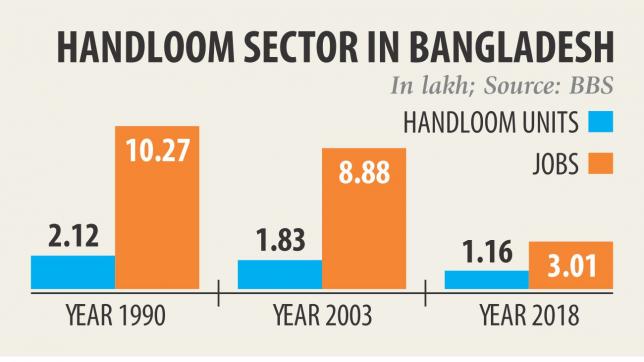Handlooms on the decline

The number of handlooms fell by more than quarter in Bangladesh in the last 15 years, cutting jobs, largely because of the sector's shift towards mechanisation and dearth of labour.
In 2003, there were 183,512 handloom units but it fell 36.79 percent to 116,006 last year, according to the Handloom Census 2018 carried out by the Bangladesh Bureau of Statistics (BBS).
Planning Minister MA Mannan released the primary report of the census at a programme at the BBS auditorium in Dhaka yesterday.
The government carried out the third countrywide census on handloom last year. The previous two censuses were in 1990 and 2003.
According to the latest census report, employment also fell: 888,115 people were employed in the sector in 2013 but it declined by 194 percent to 301,157 in 2018.
Number o women workers fell by 55.78 percent to 168,313 and men by 44.22 percent to 133,444 during the period.
However, in percentage, the women's participation in the labour force rose: they made up 44.35 percent of the workforce in 1990 and it rose to 46.81 percent in 2003 and 55.78 percent in 2018.
There are significant numbers of women workers in the three hilly districts: Rangamati, Khagrachhari and Bandarban.
Apart from increasing mechanisation, lower income, lack of capital, and problems related to marketing were blamed for the squeezed handloom sector.
“Handloom is our traditional industry, but it is about to disappear. So, the government has moved to formulate proper plans for the development of the sector,” Mannan said.
He hopes the Bangladesh Handloom Board would take necessary steps using the data and information of the census. “The government will extend necessary assistance to this effect.”
Saurendra Nath Chakrabhartty, secretary of the BBS, said the report would provide a comprehensive picture about the sector to stakeholders.
Chattogram and Rajshahi divisions are home to most of the handlooms in the country, accounting for 73.10 percent of the total. The Chattogram division also makes up 56.20 percent of the handlooms.
The census report showed 88.43 percent handloom units are located in villages, while the rest are in towns.
Krishna Gayen, director general of the BBS, said the census was aimed at evaluating the current picture of the sector, identifying operational and non-operative handlooms, and finding out the socio-economic status of handloom owners and workers.
Mohiuddin Ahmed, project director of the census, and Md Zahidul Hoque Sardar, director of the census wing of the BBS, also spoke.
